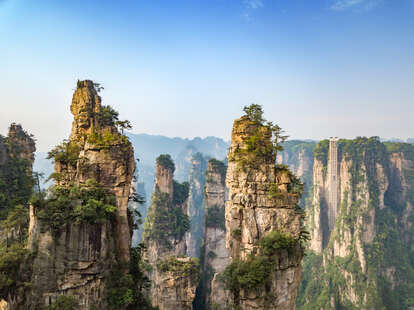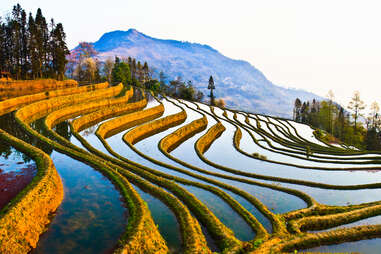
This Country's Mountains Are Basically 'Avatar' in Real Life
China's vast landscape makes for an array of movie-worthy backdrops.
China is spectacularly vast—enveloping Brazil and slightly larger than the United States—and within its borders contain a bounty of majestic scenery. You can take your pick from coastline, northern deserts, fertile river valleys, or densely packed urban centers. But personally, I’d go with the mountains.
I spent six years in China exploring many of the country’s most mind-boggling peaks on hikes and oxygen-poor bike rides, from the lunar mountains near Guilin to the undulating terrain of Yunnan Province. These near-celestial elevations bear complex ecosystems of plant and animal life that quite literally look like something out of Avatar. There’s distinct cultural riches and a sense of spiritual calm that simply can’t be found on the ground. Plus, the eye candy is just straight-up ludicrous.
Here is a list of the most bewitching mountains in China. Bookmark it to see them yourself someday.

Yuanyang
Yunnan Province
Upon arriving in a bar in the Yunnan capital of Kunming with a phone full of mediocre photos of Yuanyang, an unimpressed friend scoffed to me: “Mate, if you can’t take a good photo of Yuanyang, you can’t take a good photo of anything.” There is no single item more symbolic of China than a rice terrace, and no rice terrace in China—or perhaps the world—is more beautiful than Yuanyang, which reaches elevations well above 6,000 feet.

Changbai
Jilin Province
Compared to the lush vegetative South, Northeast China is about as dramatic as a Microsoft Windows instructional video. But Changbai Mountain is the big, whopping exception: It’s a stunning national park near China’s border with North Korea, with volcanic structures and a glacial caldera so ethereal they call it Heaven Lake. It's also one of the few homes of the rare Siberian tiger, considered to be the largest tiger in the world and with fewer than 600 in existence.

Zhangjiajie
Hunan Province
The tall, skinny mountains in Avatar? They're real, and they're in China, a fanciful forest of peaks formed through years of explosive tectonic collisions and natural erosion, topped with tufts of pine trees. The region became the country's first national forest park, and they're not shying away from the Avatar connection: In honor of the first movie, in 2010 the name of one of the quartz-sandstone pillars was changed from Southern Sky Column to Avatar Hallelujah Mountain. It continues to be a good tourism move: the first Avatar continues to be the highest-grossing movie of all time, with a third installment to be released in 2025.

Jade Dragon Snow Mountain
Yunnan Province
The village of Lijiang near Jade Dragon Snow Mountain is beautiful, unique... and almost totally devoid of authenticity after decades of heavy-handed tourist development. But damn, what a mountain! It’s the southernmost glacier in the northern hemisphere, bringing you in touch with vegetation you won’t find anywhere else in China.

Wuyi Mountains
Fujian Province
“I wouldn’t go to China for all the tea in China,” my grandmother quipped when I told her I planned to move to Fujian Province. Fortunately, I ignored her advice and, happily, discovered that Wuyi Mountain is ground zero for oolong tea—perhaps the Middle Kingdom’s finest export. Just don’t do as I did and take the cheap bus up: Fujian’s roads are bumpy, the stops along the way are numerous, and the less said about the bathroom the better.

Huangshan (Yellow Mountain)
Anhui Province
No mountain in China is more famous. Tucked away in Anhui Province in Eastern China, the Huangshan mountain range translates to Yellow Mountain, named not for its color but for the eighth-century Yellow Emperor (Huangdi) who, according to one legend, ascended to heaven from its dramatic peaks. The mountain is a ubiquitous symbol appearing on banknotes and in paintings hung in homes and businesses throughout the country. A fun game you can play trekking in Yellow Mountain is anthropomorphizing the bizarre rock formations and jutting peaks you find. Look, an old man! A tall bird! Second to the goofy-looking rocks are Yellow Mountain’s pine trees, whose leaves are splayed out horizontally and have Dr. Seuss written all over them.

Muztagh Ata
Xinjiang
At 24,700 feet, Muztagh Ata ("ice-mountain-father") is the tallest mountain you’ve never heard of. It stands in the far west of China, a region that for centuries served as a stop on the Silk Road. For those not adventurous enough to climb it (raises hand), the mountains serve as the backdrop of nearby Karakul Lake in Tajik National Park, one of the world’s clearest.

Emei Mountain
Sichuan Province
Some graffiti I encountered at a youth hostel at the foot of Sichuan’s Mount Emei proved prophetic: “Beware the monkeys—and the monks.” Indeed, this UNESCO World Heritage Site, one of the four sacred Buddhist mountains, features rambunctious little primates who might make a play for your camera—and monks who’ll make a bid for your wallet. Despite these obstacles and the hordes of Chinese tourists, Emei’s beauty and Buddhist history make the trip worthwhile. The biggest attraction is the mountain's second highest peak, the Golden Summit, with structures that dazzle in the sunlight.

Karakoram Highway
Xinjiang
Even if it weren’t ringed by beautiful scenery, the Karakoram Highway (also known as the Friendship Highway) would be notable for a number of reasons: It is among the world’s highest paved roads, and one of its most landlocked. The corridor from China to Pakistan, the highway passes through the Karakoram mountains and is worlds away from the bustling cities on China’s east coast.

Leshan
Sichuan Province
If you think of the sheer number of Buddhas in the world—mean, just think of it—having the world’s largest one is no small accomplishment. The sitting Buddha at Leshan stands (sits?) at over 230 feet high at the confluence of the Min River and Dadu River, carved out of sandstone, and took 90 years to build, between 713 and 803 during the Tang dynasty. The length of time may account for its impatient-looking facial expression.

Tian Shan
Xinjiang
Tianshan refers to a mountain range spanning four separate countries: China, Kazakhstan, Uzbekistan, and Kyrgyzstan. Its name in Chinese means “celestial mountains,” which, at more than 24,000 feet, seems apt.

Wutai
Shanxi Province
Shanxi is kind of like the West Virginia of China, a province famous for coal production and one whose pollution has set (unflattering) records. Wutai Mountain is a much-needed escape: a holy Buddhist mountain—another of the four sacred mountains in Chineses Buddhism—with over 53 temples, stunning views, and fresh air.
Additional reporting by Vanita Salisbury.